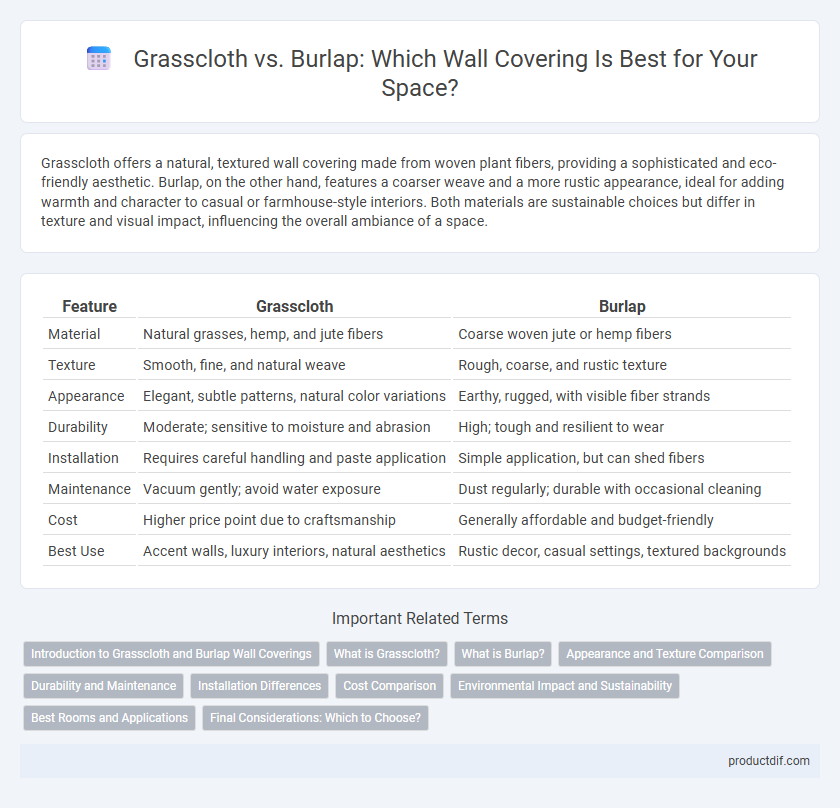Grasscloth offers a natural, textured wall covering made from woven plant fibers, providing a sophisticated and eco-friendly aesthetic. Burlap, on the other hand, features a coarser weave and a more rustic appearance, ideal for adding warmth and character to casual or farmhouse-style interiors. Both materials are sustainable choices but differ in texture and visual impact, influencing the overall ambiance of a space.
Table of Comparison
| Feature | Grasscloth | Burlap |
|---|---|---|
| Material | Natural grasses, hemp, and jute fibers | Coarse woven jute or hemp fibers |
| Texture | Smooth, fine, and natural weave | Rough, coarse, and rustic texture |
| Appearance | Elegant, subtle patterns, natural color variations | Earthy, rugged, with visible fiber strands |
| Durability | Moderate; sensitive to moisture and abrasion | High; tough and resilient to wear |
| Installation | Requires careful handling and paste application | Simple application, but can shed fibers |
| Maintenance | Vacuum gently; avoid water exposure | Dust regularly; durable with occasional cleaning |
| Cost | Higher price point due to craftsmanship | Generally affordable and budget-friendly |
| Best Use | Accent walls, luxury interiors, natural aesthetics | Rustic decor, casual settings, textured backgrounds |
Introduction to Grasscloth and Burlap Wall Coverings
Grasscloth wall coverings are made from natural fibers such as hemp, jute, or reeds woven together, offering a textured, organic look that enhances interiors with warmth and subtle elegance. Burlap, crafted from coarse jute fibers, provides a rustic, durable option with a rougher texture and a more casual aesthetic compared to grasscloth. Both materials are biodegradable and eco-friendly, making them popular choices for environmentally conscious design while delivering unique tactile and visual appeal.
What is Grasscloth?
Grasscloth is a natural wall covering made from woven fibers of various grasses, such as hemp, jute, and arrowroot, creating a textured and organic look that adds warmth and depth to interior spaces. Its unique handwoven construction results in slight texture variations, making each roll one-of-a-kind and ideal for accent walls or subtle backgrounds. Grasscloth is breathable and environmentally friendly but requires careful maintenance due to its sensitivity to moisture and staining.
What is Burlap?
Burlap is a coarse, woven fabric made from jute or hemp fibers, commonly used in wall coverings for its rustic texture and natural appearance. It offers durability and breathability, making it suitable for adding warmth and organic appeal to interiors. Unlike grasscloth, burlap has a rougher feel and a more open weave, which can create a bold, tactile statement on walls.
Appearance and Texture Comparison
Grasscloth wall coverings feature natural fibers woven in a tight, intricate pattern, creating a smooth yet tactile surface with subtle variations in color and texture. Burlap offers a coarser, more rugged appearance, characterized by a loose weave and rough texture that adds a rustic, earthy feel to walls. The refined, elegant look of grasscloth contrasts with burlap's organic, raw aesthetic, making each choice distinct in visual and tactile impact.
Durability and Maintenance
Grasscloth wall coverings offer moderate durability but require careful maintenance due to their natural fibers, which are prone to staining and moisture damage. Burlap is more durable and resistant to wear and tear, making it suitable for high-traffic areas, but it demands regular dusting to prevent fiber buildup. Both materials benefit from gentle cleaning methods, avoiding harsh chemicals that can degrade their texture and appearance.
Installation Differences
Grasscloth requires careful handling during installation due to its delicate natural fibers, needing a professional adhesive and precise alignment to prevent tearing and uneven seams. Burlap is thicker and more durable, making it easier to install with standard wallpaper paste and allowing for minor adjustments without damage. Both materials benefit from proper wall preparation, but burlap's robustness offers a more forgiving installation process compared to the fragile texture of grasscloth.
Cost Comparison
Grasscloth wall coverings typically cost between $5 to $15 per square foot, reflecting their natural, handwoven construction from hemp, jute, or arrowroot fibers. Burlap is generally more affordable, averaging around $3 to $8 per square foot, due to its coarser texture and less intricate weaving process. Choosing between the two depends on budget constraints and desired aesthetic, with grasscloth offering a premium look at a higher price point.
Environmental Impact and Sustainability
Grasscloth wall coverings, derived from natural fibers like hemp, jute, and seagrass, offer a highly sustainable option due to their renewable sources and biodegradability. Burlap, made primarily from jute fibers, is also eco-friendly but typically involves intensive processing and chemical treatments, which can increase its environmental footprint. Choosing grasscloth reduces environmental impact through minimal processing and renewable harvesting, making it a preferred choice for sustainable interior design.
Best Rooms and Applications
Grasscloth wallcovering, known for its natural fiber texture and elegant appearance, excels in living rooms, dining rooms, and bedrooms where a sophisticated yet organic ambiance is desired. Burlap, with its coarse and rustic texture, suits casual spaces like home offices, accent walls, and entryways, adding a warm, earthy character that complements farmhouse or industrial decor. Both materials perform best in low-moisture environments due to their natural fiber composition and sensitivity to humidity.
Final Considerations: Which to Choose?
Grasscloth offers a natural, textured wall covering made from woven grasses, providing an elegant and eco-friendly finish, while burlap delivers a more rustic appearance with a coarser weave and greater durability. Choosing between grasscloth and burlap depends on the desired aesthetic, room usage, and maintenance preferences, as grasscloth is more delicate and harder to clean, whereas burlap withstands wear better but may not offer the same refined look. Consider factors such as humidity levels, traffic, and budget to select the most suitable wall covering for your space.
Grasscloth vs Burlap Infographic

 productdif.com
productdif.com